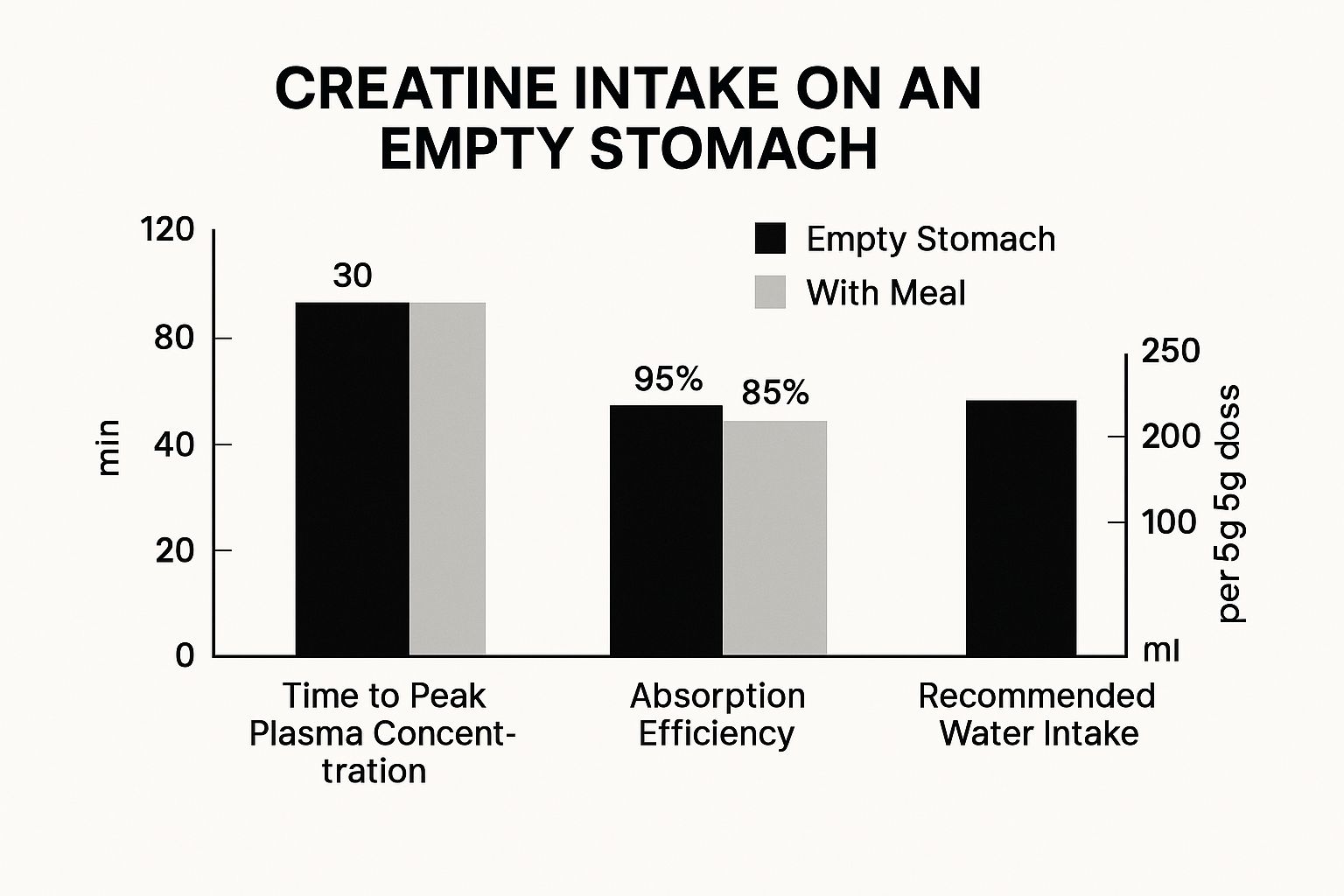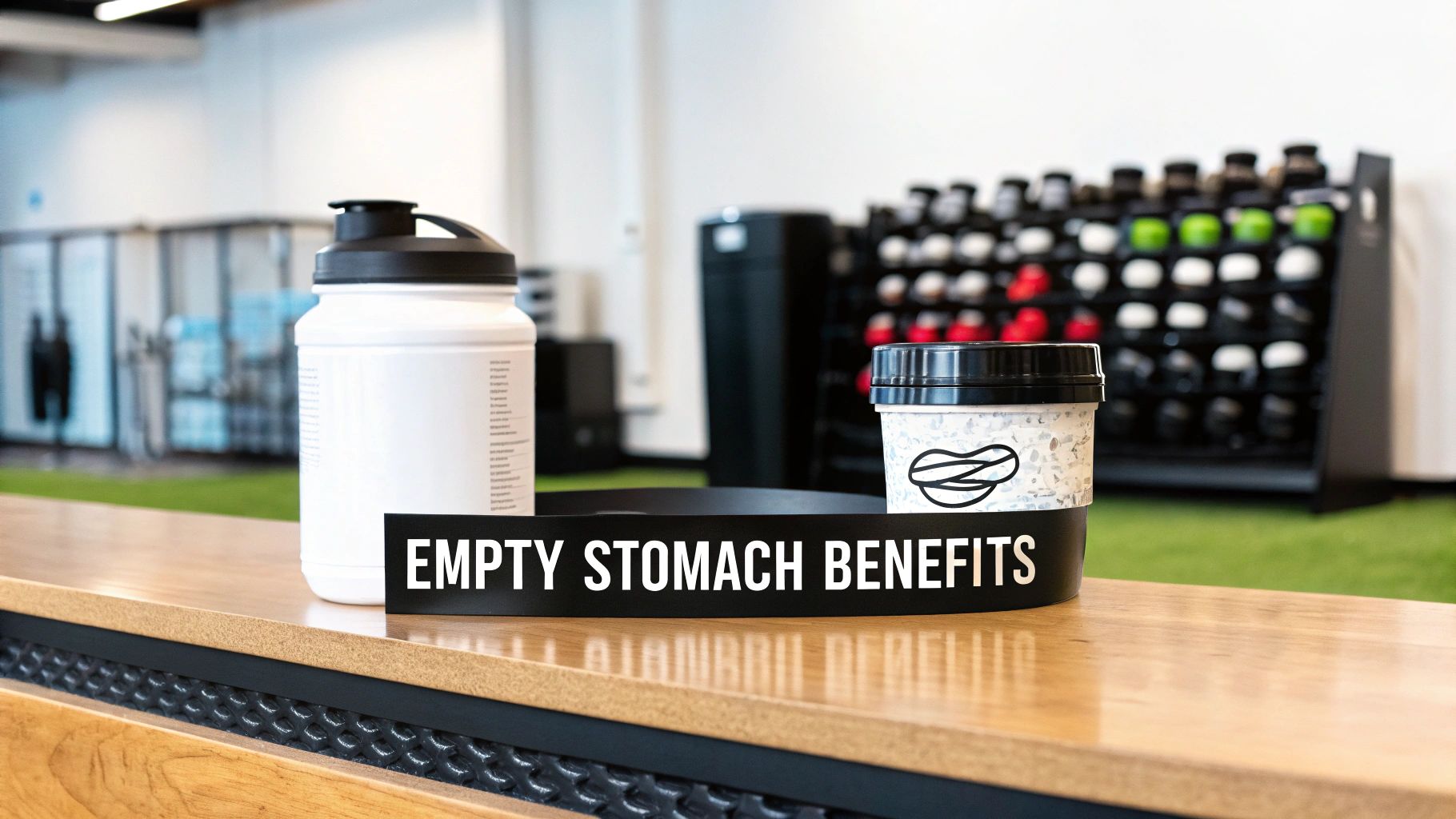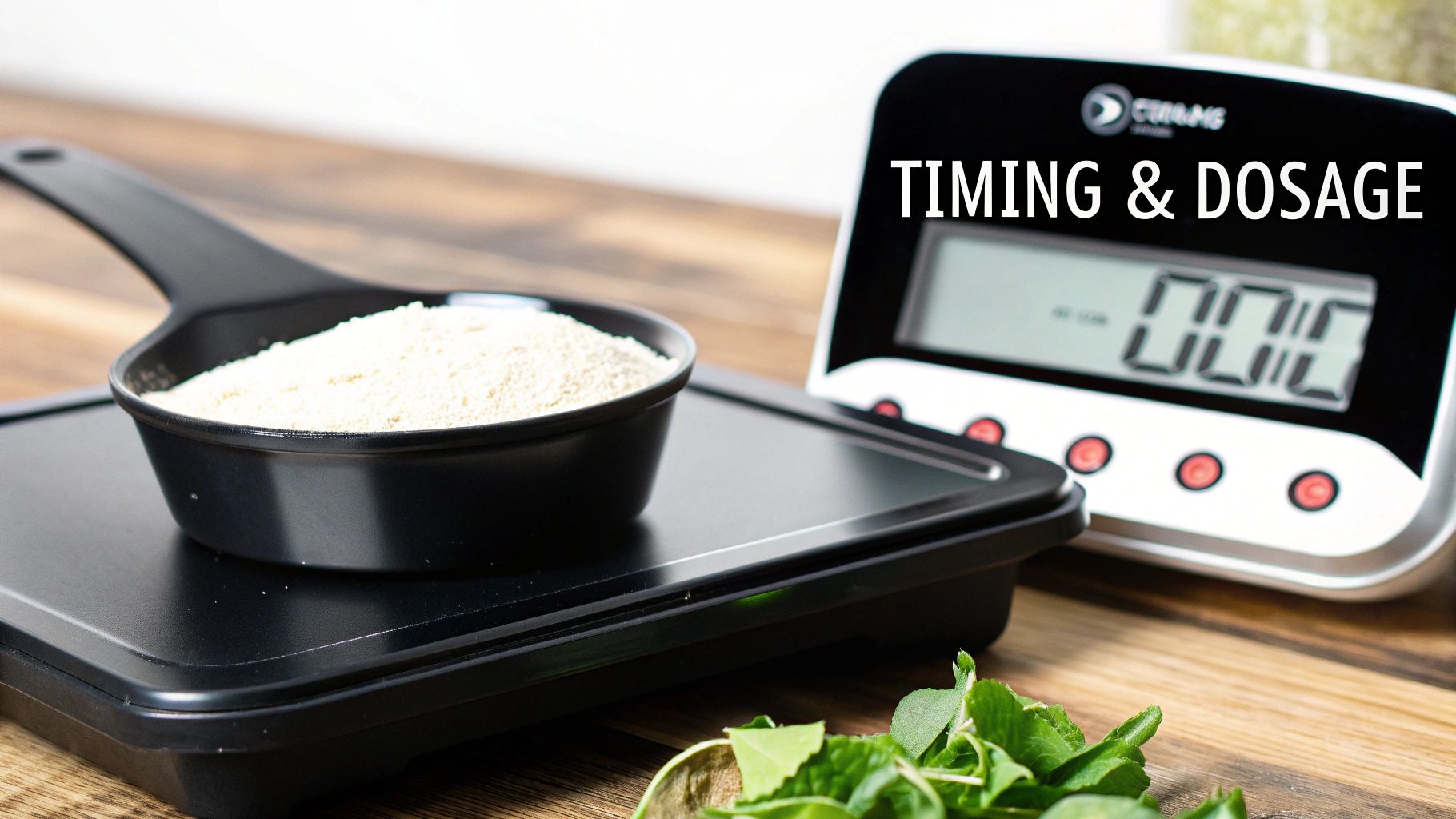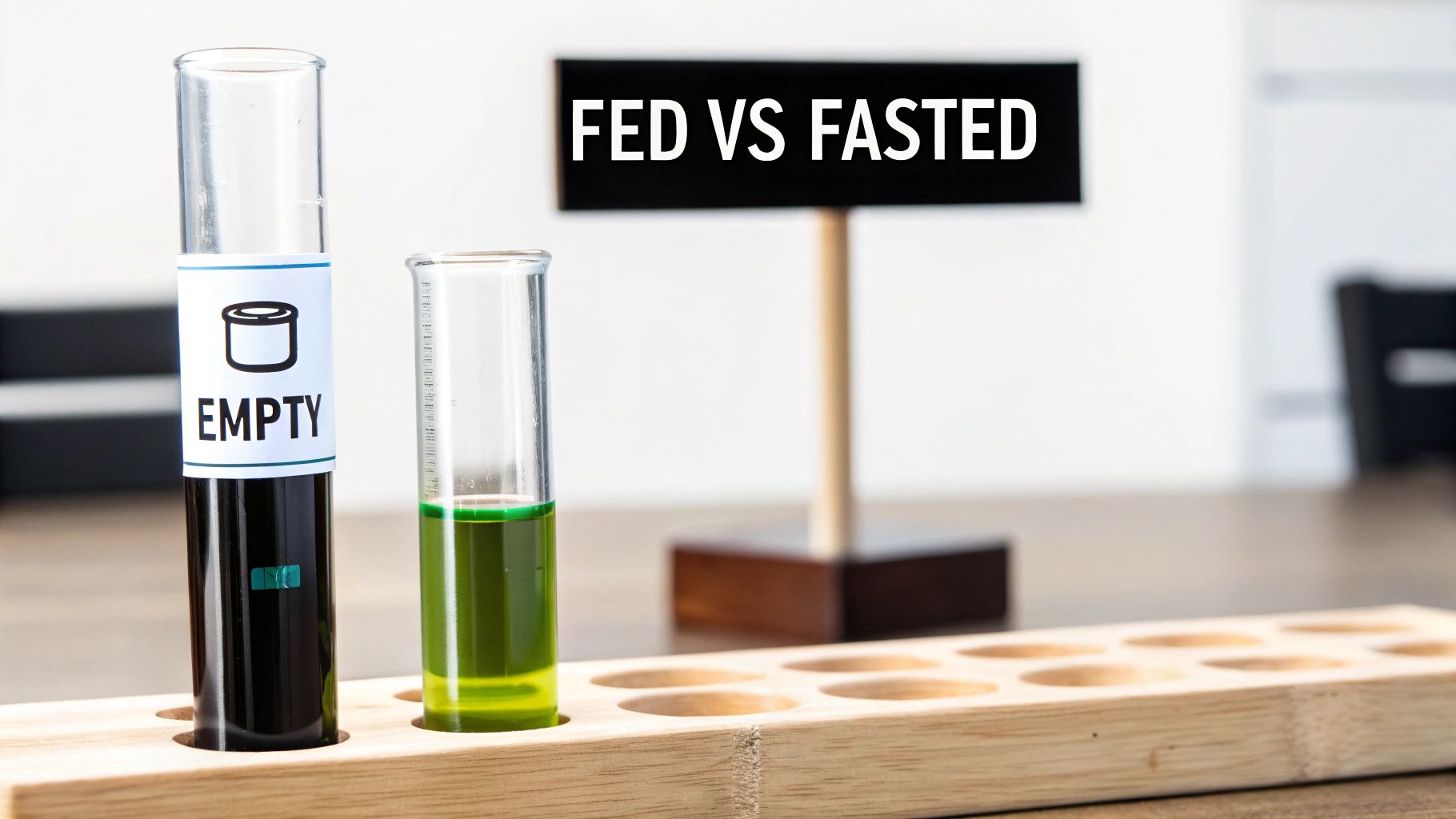
Creatine on an Empty Stomach Is It a Good Idea
Share
Yes, you can absolutely take creatine on an empty stomach. The real question is, should you? It really comes down to a trade-off between potentially faster absorption and the risk of some stomach discomfort. There's no one-size-fits-all answer here; it's all about what works for your body and your routine.
The Quick Answer on Taking Creatine on an Empty Stomach
So, should you take creatine on an empty stomach? It depends on what you value most: convenience and speed, or maximum comfort and absorption efficiency.
For some people, especially early morning trainers or those who practice intermittent fasting, downing creatine first thing is just easier. It gets it done. Think of your digestive system as a clear road in the early morning—the creatine gets a straight shot to where it needs to go.
The potential downside? That solo journey can sometimes irritate the stomach lining, leading to bloating, cramps, or nausea in sensitive individuals.
It’s worth noting that consistency is far more important than a few minutes of difference in absorption time. The ultimate goal is to keep your muscles saturated with creatine, and that happens by taking it daily, regardless of the exact timing. If taking it on an empty stomach fits into your lifestyle, and you feel fine, go for it.
Understanding the Trade-Offs
The whole debate really boils down to two things: absorption speed versus potential digestive issues.
Taking creatine with a meal containing carbohydrates and protein is known to create a small insulin spike. This insulin response acts like a key, helping to unlock your muscle cells and shuttle the creatine inside more efficiently. It’s a well-established method for maximizing uptake.
That said, taking it on an empty stomach still works perfectly well for saturating your muscles. The creatine will get absorbed. The main drawback is that for some, it can be a bit harsh. If you're doing a loading phase with 20-25 grams a day, splitting that into smaller 5-gram doses is a smart move to avoid overwhelming your gut.
A great pro tip is to dissolve your creatine powder completely in a slightly warm liquid. Gritty, undissolved creatine is a common culprit behind stomach issues. You can find out more about how creatine fits into a fasted state in our guide on whether creatine breaks a fast.

To make it even clearer, let's break down the differences side-by-side.
Creatine With Food vs On an Empty Stomach
This table gives you a quick snapshot of the key considerations for each method.
| Factor | On an Empty Stomach | With a Meal (Carbs/Protein) |
|---|---|---|
| Absorption Speed | Potentially faster due to no competition from other nutrients. | Slightly slower, as it's digested alongside food. |
| Muscle Uptake | Effective, but lacks the insulin-driven boost. | Enhanced, as insulin helps transport creatine into muscles. |
| Digestive Comfort | Higher risk of stomach upset, bloating, or nausea for some. | Generally easier on the stomach and better tolerated. |
| Convenience | High, especially for early morning training or fasting. | Requires planning around mealtimes. |
| Best For | Experienced users, those who train fasted, or individuals with robust digestive systems. | Anyone prone to stomach issues, beginners, or those looking to maximize every gram. |
Ultimately, both paths lead to the same destination: saturated muscles ready to perform. The "best" route is simply the one you can stick with consistently without any negative side effects. Don't be afraid to experiment and see what feels right for your body.
How Your Body Absorbs Creatine Without Food

When you take creatine without any food, you're essentially giving it a VIP pass straight through your digestive system.
Picture your stomach as a busy sorting facility. When it's full of food, every supplement, vitamin, and nutrient has to get in line to be processed and shipped out. Taking creatine on an empty stomach is like sending a priority package when the facility is nearly empty. There’s no traffic and no competition, so it gets processed and absorbed into your bloodstream much faster.
This can create a quicker initial spike in blood creatine levels. But a faster delivery to the bloodstream isn't the whole story. The real mission is getting that creatine out of the blood and into your muscle cells where it actually does its job.
The Journey Through Stomach Acid
It's natural to wonder if harsh stomach acid might break down creatine before it even has a chance to be absorbed. Thankfully, creatine is a remarkably tough molecule. It’s more than stable enough to survive the acidic conditions of your stomach mostly unharmed.
Research confirms that the overwhelming majority of creatine passes through the stomach just fine, arriving in the small intestine ready for absorption. From there, it enters the bloodstream and heads toward your muscles.
While absorption might be quicker without food, the overall bioavailability—the amount of creatine that actually gets into your system for use—is extremely high whether you've eaten or not. You're not "wasting" creatine by taking it with just water.
This efficient process means your body can use the supplement effectively either way. The real difference comes down to the next, crucial step.
The Missing Key: Insulin's Role
This is where the distinction between taking creatine with food versus without really matters. For creatine to move from your bloodstream into your muscle cells, it needs a little help. It relies on special transporters, and the hormone insulin acts like the master key that unlocks them.
When you eat a meal, especially one containing carbohydrates, your body releases a surge of insulin. This insulin spike is a powerful signal to your muscle cells, telling them to open their doors and pull in nutrients, including creatine. It's a highly effective delivery system.
Taking creatine alone means you don't get that significant insulin release. The creatine transporters still function, but they aren't working at peak efficiency without that insulin "key." So, while the initial absorption into your blood is faster, the final step of shuttling it into your muscles might be a bit slower. This interplay between creatine and carbs is precisely why they're often paired together for maximum uptake.
This doesn't make taking creatine on an empty stomach ineffective—not at all. Your muscles will still become saturated over time. It just means the process is more of a steady trickle into your muscles rather than a powerful flood. For most people, the convenience of taking it whenever you want far outweighs this subtle difference in uptake speed.
Maximizing Absorption and Avoiding Stomach Up
While taking creatine on an empty stomach is definitely convenient, if you're chasing peak performance, you'll want a slightly different game plan. The real key to getting the most out of every scoop is creating a powerful transport system to shuttle creatine directly into your muscle cells. And the best way to do that? With food.
Think of an insulin spike as a dedicated delivery driver for your creatine. When you eat carbohydrates and protein, your body releases insulin. This hormone acts like a key, unlocking your muscle cells so they can soak up nutrients from your bloodstream. When creatine is floating around during this spike, it gets a first-class ticket right into your muscles.
This isn’t just theory—it’s how our bodies are wired. Pairing creatine with a meal helps maximize its uptake and retention, ensuring every gram you take is put to work building strength and power.
Smart Strategies for an Empty Stomach
So, you're set on taking creatine on an empty stomach. No problem. You don’t have to miss out on the benefits, you just have to be a little smarter about it. You can essentially create a "mini" transport system without a full meal.
Here are a couple of pro tips:
-
Add a Splash of Juice: Mixing your creatine with a small amount of a simple carb source, like grape or apple juice, can trigger a modest insulin release. It’s just enough of a nudge to help shuttle more creatine into your muscles.
-
Dissolve It Completely: This is a big one. One of the main reasons people get an upset stomach from creatine is that the powder isn't fully dissolved. Undissolved grit sitting in your gut is a recipe for discomfort. A simple fix is to mix it in a warm liquid, like tea or even just warm water. This massively improves its solubility, making it far gentler on your digestive system.
The type of creatine you're using also matters. If you have a sensitive stomach, it's worth exploring the differences between monohydrate or micronized creatine. Finer, micronized powders tend to dissolve much more easily.
The Science of Nutrient Synergy
When it comes to creatine, what you take it with can be just as important as when you take it. Research consistently shows that consuming creatine with a carbohydrate-rich meal significantly boosts how much of it your muscles absorb. This is all thanks to that insulin-mediated pathway we talked about.
Taking it a step further, combining creatine with both protein and carbs seems to be the sweet spot. This combo not only spikes insulin but also increases blood flow and overall nutrient delivery to your muscles, enhancing retention even more. You can dive deeper into the research behind creatine timing and absorption at nakednutrition.com if you want to nerd out on the science.
The Takeaway: Taking creatine on an empty stomach works for saturating your muscles over the long haul. But for maximizing immediate absorption and sidestepping potential stomach issues, pairing it with carbs and protein is the gold standard.
At the end of the day, the best method is the one you can stick with day in and day out. Whether you go for the convenience of an empty-stomach dose or the optimized absorption of a post-meal scoop, consistency is what truly drives results.
When Taking Creatine on an Empty Stomach Makes Sense

While the textbook advice is to take creatine with a meal to boost absorption, life doesn't always operate like a textbook. We're all busy, and sometimes, perfect supplement timing just isn't in the cards. In a few very common situations, taking creatine on an empty stomach isn't just a backup plan—it's actually the most practical and effective way to go.
When it comes to creatine, consistency is king. Seriously. If taking it on an empty stomach is what helps you stick to your daily dose without fail, then that’s the best method for you.
Let's break down a few scenarios where this approach really shines.
For the Early Morning Athlete
It's 5 a.m., your alarm is blaring, and your workout is calling. The last thing you want is to force down a full breakfast that will slosh around in your stomach during your first set. This is the perfect example of when taking creatine with a simple glass of water is the way to go.
You get the supplement into your system to support your training, but you don't have to deal with feeling weighed down or bloated. If this is you, keep these tips in mind:
- Stick to the Standard Dose: A simple 3-5 gram serving is all you need. Trying to load up with a bigger dose on an empty stomach is just asking for digestive trouble.
- Pick a Quality Formula: Go for a micronized creatine monohydrate. It dissolves much better in water, which can make it easier on your gut when there’s no food to buffer it.
This strategy lets you stay consistent with your creatine schedule without compromising your comfort or performance during those pre-dawn sessions.
For Intermittent Fasters
Intermittent fasting has become a go-to lifestyle for many, but it can complicate supplement timing. If your workout falls squarely in your fasting window, you need a way to get your creatine in without breaking that fast.
This is where pure creatine monohydrate becomes your secret weapon. Because it has no calories and doesn't trigger a meaningful insulin response, it will not break your fast. This means you can keep your muscles saturated and ready for action while staying true to your fasting goals.
The crucial thing here is to use a pure, unadulterated creatine product. Many formulas come loaded with extra sugars, BCAAs with artificial sweeteners, or other fillers that pack a caloric punch and will definitely kick you out of a fasted state.
When Meals and Supplements Just Don't Mix
Let's be honest—some of us just don't feel great when we mix supplements with a big meal. It can lead to feeling overly full, bloated, or just generally "off," which can be just as bad as any discomfort from taking it on its own.
Your body knows best. If you feel better separating your creatine from your meals, then do it. Taking your daily dose an hour before or after you eat is a perfectly sound strategy. Ultimately, the goal is to build a routine that feels good and that you can maintain day in and day out without a second thought.
Choosing the Right Type of Creatine
Not all creatine is the same, and this becomes especially true when you’re taking creatine on an empty stomach. The right choice can be the difference between a great workout and an upset stomach. It really boils down to a balance between what’s proven, what’s affordable, and what your own body tells you.
For most people, the conversation begins and ends with Creatine Monohydrate. It’s the old faithful—the most studied, most effective, and cheapest form out there. Think of it as the original workhorse that’s been fueling athletes for decades. Its only real hiccup can be its solubility. If it doesn’t fully dissolve, those leftover gritty bits can sometimes lead to bloating or cramps, and that risk goes up a bit without food to cushion the blow.
Exploring Alternatives for Sensitive Stomachs
So what do you do if standard monohydrate just doesn’t agree with you? Thankfully, there are a few alternatives designed to be gentler on the gut.
One of the most popular is Creatine Hydrochloride (HCL). The big selling point here is its chemistry—its unique structure makes it much more soluble in water than monohydrate. In practice, better solubility means less undissolved powder hitting your stomach, which often translates to fewer issues and allows for a smaller dose.
Then there’s Buffered Creatine, which you might see sold under brand names like Kre-Alkalyn. This version is processed to have a higher pH level. The idea is that this makes it more stable in your stomach’s acidic environment, preventing it from breaking down into creatinine (a useless waste product) before it can be absorbed. This improved stability is claimed to boost absorption and reduce side effects.
Now, while these newer forms sound great on paper, it's crucial to remember that creatine monohydrate is still the gold standard, with hundreds of scientific studies backing its effectiveness. The performance edge of HCL or buffered versions has never been definitively proven, but for some people, the improved digestibility is a game-changer.
Comparing Your Options
Ultimately, the best type of creatine for you is the one you can take consistently without any discomfort. For many, simply choosing a high-quality micronized monohydrate does the trick. Micronized powders are milled into much finer particles, which helps them dissolve almost instantly.
But if you’ve already tried that and are still having trouble, giving HCL or buffered creatine a shot is a perfectly reasonable next step.
To make things a bit clearer, let's look at how these common forms stack up against each other, especially when it comes to taking them without food.
Comparing Creatine Types for Stomach Comfort
This table compares common creatine forms based on solubility, typical dosage, and reported tolerance when taken without food.
| Creatine Type | Solubility | Typical Dose | Potential for GI Issues |
|---|---|---|---|
| Monohydrate | Standard | 3-5 grams | Low, but higher if not fully dissolved. |
| Creatine HCL | Very High | 1-2 grams | Very Low, due to better solubility. |
| Buffered Creatine | Standard | 1.5-3 grams | Very Low, due to higher pH stability. |
As you can see, while monohydrate is the go-to, the alternatives offer compelling benefits if your primary concern is avoiding digestive issues. Don't be afraid to experiment to find what works best for your body and your goals.
Building Your Personal Creatine Strategy

Alright, let's move past the black-and-white debate and build a creatine plan that’s actually tailored to you. The secret to smart supplementation isn't finding one magic answer. It's about knowing the rules of the game so you can apply them to your own body, schedule, and goals.
So, here's the bottom line: taking creatine on an empty stomach is a perfectly fine and often convenient option. It works well for muscle saturation, especially if you're an early bird hitting the gym or someone who practices intermittent fasting.
That said, taking it with food is still the gold standard for a reason. Combining creatine with carbs and protein triggers a helpful insulin response that can shuttle it into your muscles more efficiently and helps sidestep any potential gut issues.
Your Action Plan for Success
Whichever route you choose, a few fundamentals will make or break your results. Think of these as the non-negotiables for getting the most out of every single scoop.
-
Hydration is Paramount: Creatine works by pulling water into your muscle cells. To support this process and stay hydrated, you absolutely have to drink plenty of water all day long.
-
Ensure It’s Fully Dissolved: That gritty, sandy texture at the bottom of your shaker? That's the number one culprit behind stomach cramps. Mix your creatine until the water runs clear, even if it means using slightly warmer water to help it dissolve.
-
Listen to Your Body: This is crucial. Pay close attention to how you feel. If you start experiencing bloating or an upset stomach, don't just push through it. The fix is simple: start taking your daily dose with a small meal or snack.
The single most important factor for success with creatine is not the exact timing of your dose. It is consistency. Taking it daily is what allows your muscles to become fully saturated, unlocking the performance benefits you’re after.
At the end of the day, the best strategy is the one you can stick to without thinking about it.
Whether you mix it into your morning oatmeal or chug it with water before the sun is up, consistency is king. And as you dial in your routine, it's smart to see how creatine fits alongside other effective natural muscle building supplements to create a truly complete approach.
Find what works for you, make it a daily habit, and let the results do the talking.
Your Questions About Creatine Timing, Answered
Getting into the weeds with supplements can feel a bit overwhelming, but it really doesn't need to be. To cut through the noise, let's tackle the most common questions people have about creatine, especially when it comes to taking it on an empty stomach. Here are the simple, no-nonsense answers you're looking for.
Can I Take Creatine With Just Water on an Empty Stomach?
Yes, you absolutely can. For many people, it's the easiest and most convenient way to get their daily dose in.
The real trick to avoiding any potential stomach upset is just making sure the powder is fully dissolved before you drink it down. Mixing it with slightly warm water can help it dissolve much faster. If you're new to creatine, a standard dose of 3-5 grams is the perfect place to start. If you do feel a little bloating, just try having your next dose with a small, simple snack like a banana to see if that helps.
Does Taking Creatine on an Empty Stomach Break a Fast?
This is a big one for anyone practicing intermittent fasting. The short answer is no. Pure creatine monohydrate has no calories and doesn't trigger a meaningful insulin response. So, taking creatine on an empty stomach won’t break your fast.
This actually makes it a great supplement if you like to train during your fasting window. The only catch is what you mix it with. If you toss it into juice, a sugary sports drink, or anything else with calories, you’ll definitely break your fast. Stick with pure creatine and plain water, and you're good to go.
The Verdict: Pure creatine is your ally during a fast. Because it's calorie-free, you can keep your muscles supplied for a great workout without interfering with your fasting goals.
How Long Should I Wait to Eat After Taking Creatine?
There’s no hard-and-fast rule here. You don’t need to wait a specific amount of time before eating. Creatine gets absorbed by your body pretty quickly—usually within an hour or so—so feel free to eat whenever you’re ready.
You can have a meal right after you take it or wait a while; it’s totally up to you. In fact, having a meal with carbs and protein soon after your dose can actually be a good thing. It creates a natural insulin spike that can help shuttle that creatine into your muscle cells even more efficiently.
Will I Lose Benefits if I Take It on an Empty Stomach?
Not at all. You won't miss out on the core benefits of creatine just because you took it without food. The whole point of supplementing with creatine is to fill up your muscle stores and keep them topped off. When it comes to creatine, consistency is far more important than timing it perfectly with a meal.
Sure, taking it with some carbs might speed up absorption a tiny bit, but a dose on an empty stomach still gets the job done. As long as you take it daily, you’ll see the same powerful improvements in strength, power, and overall performance.
Ready to simplify your creatine routine for good? Smash.com offers delicious, mess-free creatine gummies that deliver your full 5g dose without any powders or shakers. Upgrade your supplementation and smash your goals with Smash.com.